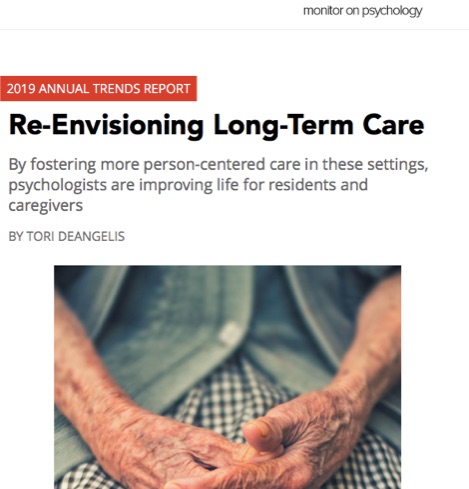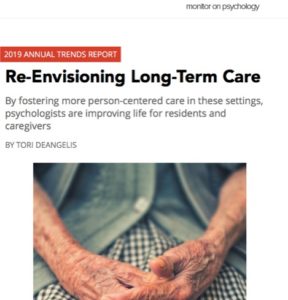Category: Resident care
Posted by Dr. El - April 7, 2020 - McKnight's Long-Term Care News, Resident care

I live in New York City, the COVID-19 epicenter of the U.S. There are long lines for the few open supermarkets, the parks are closed and the nursing homes in New York are now mandated to accept COVID residents from local hospitals.
I’m in touch with psychologist colleagues from around the area. Some facilities have personal protective equipment for their staff regardless of whether or not they have known COVID cases; others are less prepared and less open with their staff about the coronavirus, increasing the anxiety level of their team members.
I was relieved to see the McKnight’s headline last week, “Trump wants masks on all nursing home workers, temperature checks for all, and separate COVID-19 units.” Finally, I thought to myself. Perhaps facilities in other parts of the country will be spared what we’re going through in New York, where the regulations trailed the virus and 1 in 4 facilities have COVID residents as of last week’s reports. It is, in a word, grim.
To get through, I’m trying to focus on being of service, when I can focus at all.
I’ve been issued an N95 mask and a face shield, and I receive a daily surgical mask. I purchased a cane that folds out into a seat so I can maintain a safe distance from my residents and avoid sitting on anything in their rooms. I put my phone in a plastic pouch that hangs from my neck, for easy access and easy cleaning. I obsessively sanitize my hands. At the end of the day, I wipe down anything reusable.
Despite my frightening garb, my patients are happy to see me. “I’ve been waiting for you!” one man exclaimed. “I have to talk to you.”
For the entire article, visit:

Posted by Dr. El - March 13, 2020 - McKnight's Long-Term Care News, Resident care, Role of psychologists


As the number of coronavirus cases increases around the world, providers may be worried about the emotional impact of the outbreak on residents and how to handle it. One would expect residents to be concerned, given that they’re at higher risk due to their ages, underlying health problems and residence in a communal setting.
Rather than mass panic, my experience and an informal query of my psychologist colleagues suggests that they may not be as worried as you’d think. As of last week, remarkably few of them have raised the issue in psychotherapy sessions (where uneasiness of every kind is discussed).
My colleagues and I speculate that the majority of residents are not unduly alarmed about the situation due to a combination of factors: more pressing problems, successful passage through many prior hardships, fatalism (i.e., “At this age, something’s going to get me”), denial (“it’s happening far away”), and trust that the facility will keep them safe.
Nevertheless, despite their general calm and resilience, it’s perfectly reasonable for residents to have questions and concerns. There will be some who are deeply unsettled by the prospect of the virus, particularly those with anxiety disorders and people struggling with depression. There may also be individuals who have had past traumatic experiences with hospital-acquired infections, isolation precautions, or communicable illnesses such as polio.
Facilities are no doubt reviewing infection control procedures and holding staff education sessions for their employees. To address the emotional needs of residents, add a brief segment to staff training that includes the following suggestions:
- Limit the amount of time residents spend watching the news. There’s no need for them to be exposed to hours of alarming reports on the day room television.
Posted by Dr. El - January 14, 2020 - McKnight's Long-Term Care News, Resident care


Ah, January — a moment to consider plans and directions for the upcoming months. Like many people, one of my personal goals is to recommit to mindful eating and wise food choices. While some residents like to rethink their diets as a New Year’s resolution, there are good clinical reasons to review the facility’s menu at any time of the year.
Researchers have found that the diet and the stomach microbiomes of those in long-term care are significantly less diverse and healthy than those of community-based elders, with institutionalized elders eating diets that are higher in fat and lower in fiber.
Not only that, but the alteration in gut microbes are detectable within 24 hours of dietary changes, suggesting an immediate payoff to dietary improvements (and immediate deleterious effects).
Benefits of a diverse menu
Studies indicate that a more diverse, healthier menu can promote healing, reduce inflammation and help to fight infection. Moreover, there’s a line of research suggesting that the foods we eat influence not just physical health, but also mental health and moods. A healthy gut microbiome is associated with better cognition and reduced anxiety, depression and other emotional maladies.
“The tried-and-true advice of a high-fiber, low-sugar, mostly plant-based diet can benefit patients in body and mind,” author Kirsten Weir writes in “The Future of Psychobiotics” (Monitor on Psychology, December 2018).
Posted by Dr. El - December 17, 2019 - Customer service, McKnight's Long-Term Care News, Resident care, Stress/Crisis management

I know, I know, that’s not how the word is pronounced. But as soon as I read about the Danish concept of coziness, I got that darn Will Smith song (“Gettin Jiggy With It”) in my head and I can’t get it out.
Hygge (actually pronounced “hyoo-guh”) refers to the creation of a comforting, convivial environment. Think hot cocoa, warm blankets and crackling fireplaces, with loved ones.
It sounds so charming that I resolved to apply hygge to an upcoming vacation. I decided to mix local sightseeing with a few days saved for the pleasures of cooking, reading a book and watching movies with an occasional bowl of popcorn under a comforter with my family. And, of course, I considered how the idea could be applied to long-term care facilities.
Nursing homes, which could generally do with an increased focus on “home” over “nursing,” have many reasons and opportunities to add some hygge.
First and foremost is the chance to “flip the script” about being in a confined environment. Residents who have infrequent opportunities to get outside under the best of circumstances and even fewer chances during inclement weather, often feel depressed or resentful regarding their confinement. Practicing hygge offers a mental shift from a perception of restriction to one of comfort.
Holiday hygge
During the holidays, residents may observe peers going out for day passes and family members arriving for visits. For those without passes or visitors, using hygge concepts can ease their emotional pain in a kind, simple manner that emphasizes their belonging to a group.
While holiday activities such as seasonal movies and Christmas caroling are wonderful, a hygge approach would suggest adding periods of quieter comforts such as lap blankets, a fireplace video and a story read aloud. Some people might enjoy crocheting or drawing during this communal activity. If the kitchen sent up a batch of warm cookies, so much the better.
Staff hygge
Residents may not be the only ones less-than-thrilled about being at the facility on a holiday. While many staff members consider their LTC jobs a calling and are gracious about being of service to elders on Christmas or New Year’s Eve, others may be disgruntled with the holiday shift and may “leak” their emotions to their charges.
A hygge approach can soften staff resentment.
For the entire article, visit:

Posted by Dr. El - September 18, 2019 - McKnight's Long-Term Care News, Resident care

I was relieved last month when I saw that my fellow Psychologists in LTC member, Lisa Lind, Ph.D., had written an article for McKnight’s about Preparing for trauma-informed care in LTC. As McKnight’s resident behavioral health expert, I was feeling like I should write something on the subject, but I was struggling with how to do so given my apprehensions about it.
Now that Dr. Lind has provided a practical guideline, let us turn to what’s kept me up at night.
While I think it’s a good thing to pay more attention to the emotional experience of residents, I’m worried about how asking them about their traumas will be implemented in the field.
As a psychologist, residents talk to me about their painful past experiences every day. I’ve heard about children born of rapes, hidden abortions, violent childhood homes and all manner of intensely personal information, to which I was often the only one told after a lifetime of carrying a secret. It is a sacred honor to be the listener to a late-life unburdening and it comes after trust has been established over time.
Traumas are sensitive emotional wounds and I’m concerned that in their well-meaning efforts to comply with the new F-tag directives, staff members and surveyors will be poking these emotional wounds with a big stick.
There are many aspects of the situation which contribute to my uneasiness:
- Nursing homes are medically focused institutions. An in-service training or two won’t make up for the general lack of psychological training of the staff.
- Teams are still having difficulty identifying major triggers for psychological evaluation in the present day, such as an amputation or the death of a roommate.
- There are cultural and generational differences in comfort in discussing one’s personal life.
- There’s very little privacy in nursing homes. Roommates and residents seated near nursing stations and team rooms frequently overhear discussions of their peers’ personal information despite staff efforts at discretion.
For the entire article, visit:
Posted by Dr. El - August 27, 2019 - Boomers, Depression/Mental illness/Substance Abuse, McKnight's Long-Term Care News, Resident care, Younger residents

As I discussed in Severely mentally ill residents: A ‘perfect storm’ creates a SNF wave, long-term care has a growing population of severely mentally ill (SMI) residents, with the number of residents diagnosed with schizophrenia or bipolar disorder approaching 20% in some states as of 2017.1
In addition, 46.3% of LTC residents were diagnosed with depression in 2015 and 2016.2 Some were undoubtedly individuals with severe, chronic depression.
People with SMI generally enter nursing facilities for rehabilitation following a fall or some other health crisis. Discharge choices can be limited due to coexisting medical and mental health problems, leading them to become long-term residents despite their relatively young age (an average age of 62 versus 77 in the general nursing home population3).
A review of research on individuals with mental health problems, Physical illness in patients with severe mental disorders, finds that people with SMI have a greater likelihood of physical illness than those without SMI. The authors of the study note that “important individual lifestyle choices, side effects of psychotropic treatment and disparities in health care access, utilization and provision…contribute to these poor physical health outcomes.”
Their research suggests multiple points at which long-term care providers can intervene to assist SMI residents.
Medical assessment
Nurses and physicians can be taught to recognize health problems typical of the SMI population so that they’ll be alert to the increased risk of illnesses such as diabetes, metabolic syndrome, obesity-related cancers, cardiovascular diseases, osteoporosis, hepatitis B/C, tuberculosis, impaired lung function, poor dental status and other concerns.
Staff members who are comfortable physically assessing older residents might need additional training to be at ease evaluating SMI individuals, who may be more physically imposing because of their relative youth, come across as unfamiliar or frightening in their presentation or be themselves uncomfortable with medical tests or interventions.
For the entire article, visit:
Posted by Dr. El - July 5, 2019 - McKnight's Long-Term Care News, Resident care


It’s the week of Independence Day and freedom is on my mind. Residents frequently speak to me of their dissatisfaction with the limitations on their liberty, from being told to sit in a communal room when they want to be alone, to needing a family member to sign them out on pass.
“Me and the other inmates,” they say, trying to use humor to cope with their confinement.
Constraints on residents are generally due to a combination of factors, first and foremost being the physical and/or cognitive impairments that led them to require rehab or nursing home care. Psychotherapy often addresses residents’ feelings about having become ill through aging, accidents, life choices and other circumstances and it can reduce some of the blame of the nursing home for curbing their freedom.
It must be acknowledged, however, that there are many aspects of long-term care itself that limit residents, including the facility’s desire to protect residents from harm and themselves from litigation, regulatory requirements, risk-avoidance policies and routines (because “that’s the way it’s always been done and we keep passing surveys”) and inadequate staffing.
As we celebrate our freedoms in the country this week, perhaps we can consider ways in which to create a better balance between the need to provide a safe environment for residents and their right to make their own choices.
Below are just a few of the many aspects of care that could be adjusted for increased autonomy:
- Reevaluate practices that restrict residents as a matter of routine and consider instead ones that are based on their capabilities. For example, rather than disallowing all motorized wheelchairs, offer the opportunity to residents who are found to be physically and cognitively capable, pass a periodic “driver’s test” and follow established guidelines for use.
For the entire article, visit:
Posted by Dr. El - May 7, 2019 - McKnight's Long-Term Care News, Resident care

Here’s my latest article on McKnight’s Long-Term Care News:

As I developed a training program on violence prevention, I reflected on a scenario I’ve witnessed many times in my career. A resident who had been physically aggressive toward aides and nurses got sent to the hospital only after he hit the attending physician.
Situations like this send the message to nursing department staff that they aren’t important, and that violence is just part of the job. That attitude explains why nurses are estimated to report violent behaviors just 30% of the time1.
Instead of accepting aggressive behaviors as normal, facilities would be wise to approach then as anomalies that can and should be addressed. As research indicates,2 aggression toward workers decreases staff satisfaction and increases burnout. Violence prevention efforts reduce turnover costs and improve morale, and result in fewer lawsuits and a reduction in worker’s compensation claims.
Violence prevention programs
According to the Occupational Safety and Health Administration, a violence prevention program has several key elements:
- Management commitment and employee involvement
- Worksite analysis
- Hazard prevention and control
- Training and education
- Record-keeping and evaluation of program
The thrust of such programs is to support and encourage staff to report events so that there can be an accurate evaluation of the circumstances contributing to violence. Using the information gleaned from this analysis, adjustments are made to the environment and workers are trained to handle aggressive behaviors. These steps are followed by reevaluation and readjustment as needed.
The efforts can be remarkably effective. In one hospital-based program,3 Operation Safe Workplace, the incidence of violent behaviors was reduced by 55%! While hospitals have different factors contributing to these problems, such as a younger, more physically able population, there are many aspects of a long-term care environment that could be adjusted to reduce the likelihood of aggressive behaviors.
For the entire article, visit:

Posted by Dr. El - December 7, 2018 - Business Strategies, Communication, Customer service, McKnight's Long-Term Care News, Resident care

Here’s my latest article on McKnight’s Long-Term Care News:

I was recently required to take an online training module on burnout for physicians and allied professionals. It was the first time in 20-plus years that I’d received a formal message about self-care from any long-term care institution (aside from yearly staff appreciation barbecues and survey completion parties).
While I was impressed and grateful for the focus on caregiver well-being, a couple of points bothered me.
The questionnaire asked readers to select the phrase they most associated with provider burnout. There were options such as “workplace dissatisfaction” and “challenging patients.” I chose “changes in the healthcare system,” which triggered a pathway specific to that option.
I was guided through a series of vignettes discussing issues old-timers might have trouble with, such as adapting to the electronic medical record. Following the vignettes, helpful strategies were offered to manage stress.
Then came the part I found disturbing: The details of the “changes in the healthcare system” choice included “the emphasis on the healthcare experience of consumers” and “the shift from volume to value.” Let me explain why that irks me.
The experience of healthcare
Regarding consumer experience, most of my direct care team members and I have been very focused over the years on accommodating the needs of residents. It’s become more difficult, however, to maintain care quality and orderly surroundings in a healthcare environment where financial pressures have led to staff reductions and increased turnover amidst higher acuity residents.
Trying to deliver a decent customer experience without the necessary tools is part of the change in the healthcare system that induces my feelings of burnout — not the “new” attention to perceptions of consumers.
I’d be gratified to see a genuine, top-down focus on the healthcare experience of residents and their families — complete with Resident Experience Officers in every long-term care facility (sign me up!). Such an emphasis would realign resources with a mission of care that can stabilize staffing and sustain facilities over time.
Volume to value
“The shift from volume to value” stresses me in a different way.
Part of my role as a psychologist in the “volume” approach has been to aid residents in negotiating their illnesses and treatments.
If necessary, I could help them stop a lucrative but unwanted onslaught of painful medical interventions by fostering communication with their physicians and families.
For the entire article, visit:

Posted by Dr. El - November 12, 2018 - Common Nursing Home Problems and How Psychologists Can Solve Them, Psychology Research Translated, Resident care, Role of psychologists

The American Psychological Association published an article in the APA Monitor on “Trends to Watch in 2019.” I was pleased to see that geropsychology was Trend #5. Read what my colleagues and I have to say in Tori DeAngelis’ piece on Re-Envisioning Long-Term Care.











 What worries me about trauma-informed care
What worries me about trauma-informed care










